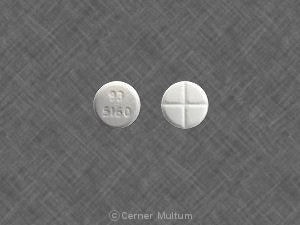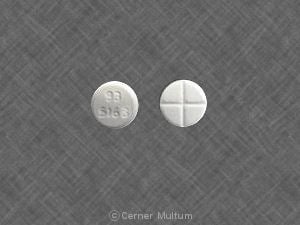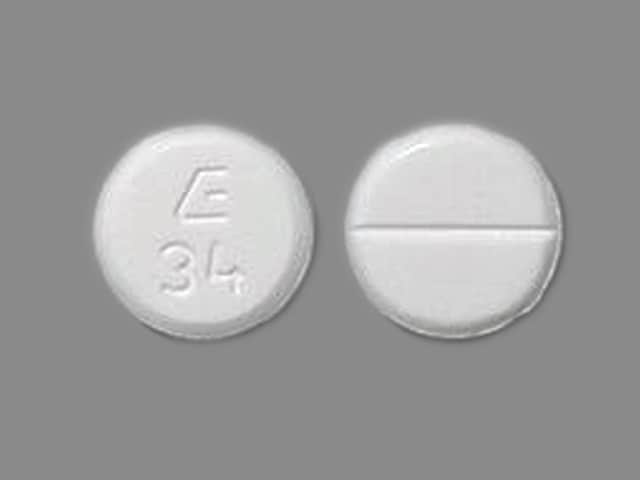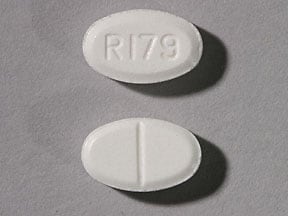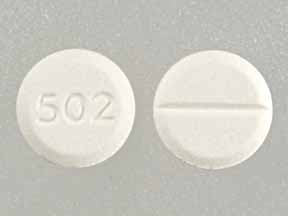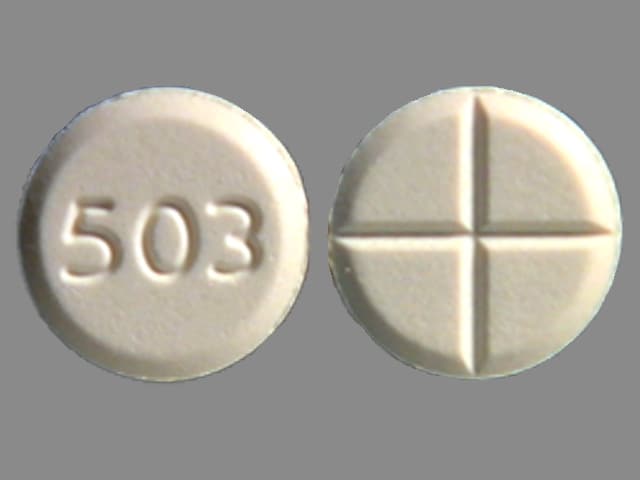Dosage Forms
Excipient information presented when available (limited, particularly for generics); consult specific product labeling.
Capsule, Oral:
Zanaflex: 2 mg, 4 mg, 6 mg
Generic: 2 mg, 4 mg, 6 mg
Tablet, Oral:
Zanaflex: 4 mg [scored]
Generic: 2 mg, 4 mg
Pharmacology
Mechanism of Action
An alpha2-adrenergic agonist agent which decreases spasticity by increasing presynaptic inhibition; effects are greatest on polysynaptic pathways; overall effect is to reduce facilitation of spinal motor neurons.
Pharmacokinetics/Pharmacodynamics
Absorption
Tablets and capsules are bioequivalent under fasting conditions, but not under nonfasting conditions.
Tablets administered with food: Peak plasma concentration is increased by ~30%; time to peak increased by 25 minutes; extent of absorption increased by ~30%.
Capsules administered with food: Peak plasma concentration decreased by 20%; time to peak increased by 2 to 3 hours; extent of absorption increased by ~10%.
Capsules opened and sprinkled on applesauce are not bioequivalent to administration of intact capsules under fasting conditions. Peak plasma concentration and AUC are increased by 15% to 20%; time to peak decreased by 15 minutes.
Distribution
2.4 L/kg
Metabolism
Extensively hepatic via CYP1A2 to inactive metabolites
Excretion
Urine (60%); feces (20%)
Onset of Action
Single dose (8 mg): Peak effect: 1 to 2 hours
Time to Peak
Fasting state: Capsule, tablet: 1 hour
Fed state: Capsule: 3 to 4 hours, Tablet: 1.5 hours
Duration of Action
Single dose (8 mg): 3 to 6 hours
Half-Life Elimination
~2.5 hours
Protein Binding
~30%
Use in Specific Populations
Special Populations: Renal Function Impairment
Clearance is reduced more than 50% in elderly patients with renal function impairment (creatinine clearance <25 mL/minute) compared with healthy subjects; this may lead to longer duration of clinical effects.
Special Populations: Hepatic Function Impairment
Extensively metabolized in the liver and significant effects are expected; use not recommended in patients with hepatic impairment.
Special Populations: Elderly
Younger subjects cleared drug 4 times faster than elderly subjects.
Use: Labeled Indications
Spasticity: Management of spasticity; reserve treatment with tizanidine for daily activities and times when relief of spasticity is most important.
Use: Off Label
Muscle spasm and/or musculoskeletal pain (adjunctive therapy)b
Data from multiple double-blind, randomized, controlled trials are supportive of the use of tizanidine (either alone or in combination with co-analgesics) in the treatment of skeletal muscle spasm and/or musculoskeletal pain Berry 1988, Hennies 1981, Pareek 2009, Sirdalud 1998, van Tulder 2003.
Contraindications
Concomitant therapy with ciprofloxacin or fluvoxamine (potent CYP1A2 inhibitors)
Dosage and Administration
Dosing: Adult
Note: Patients more sensitive to sedating and other CNS adverse effects (eg, those who are older, debilitated, or with organ impairment) may better tolerate a reduced dose, less frequent administration, and/or more gradual titration. Switching between capsules and tablets may alter effect as these preparations are not bioequivalent when administered with food; see Pharmacodynamics/Kinetics.
Muscle spasm and/or musculoskeletal pain (adjunctive therapy) (off-label use):
Note: For skeletal muscle spasm and/or pain (eg, low back pain, neck pain) with muscle spasm, usually in combination with nonsteroidal anti-inflammatory drugs and/or acetaminophen (ACP [Chou 2017]; Pareek 2009; van Tulder 2003). In general, muscle relaxants should be used temporarily (eg, for a few days or intermittently for a few days when needed) (APS 2016).
Oral: Initial: 2 to 4 mg every 6 to 12 hours as needed and/or at bedtime; some may benefit by scheduling doses initially. May increase based on response and tolerability up to a maximum dose of 24 mg/day (eg, 4 to 8 mg every 8 hours as needed) (Chou 2019; Knight 2019; Pareek 2009; van Tulder 2003).
Spasticity:
Note: For muscle spasticity due to neurologic injury or disease (eg, multiple sclerosis, stroke, spinal cord injury, traumatic brain injury, amyotrophic lateral sclerosis [ALS]) (Ashworth 2012; Chou 2004; Lindsay 2016; Nair 2014; Otero-Romero 2016; Shakespeare 2003; Taricco 2006).
Oral: Initial: 2 mg once daily usually at bedtime; may increase based on response and tolerability by 2 to 4 mg per day (with a minimum of 1 to 4 days between dose increases) up to a maximum dose of 36 mg/day in 3 or 4 divided doses. In treatment of spasticity associated with ALS, some experts limit dose to 24 mg/day (Galvez-Jimenez 2019).
Discontinuation of therapy: Gradually taper dose by 2 to 4 mg daily to reduce the risk of rebound symptoms (eg, hypertension, tachycardia, hypertonia), especially in patients receiving high doses (eg, ≥20 mg/day) for long periods (eg, ≥9 weeks) or in patients who have been receiving concomitant opioids.
Dosing: Geriatric
Use with caution; clearance is decreased. Refer to adult dosing.
Dosing: Pediatric
Note:The tablet and capsule dosage forms are not bioequivalent when administered with food.
Spasticity associated with cerebral palsy: Limited data available (Dai 2008; Dai 2016; Kliegman 2016; Patel 2005): Dosing based on small open label trials and clinical experience; tizanidine was used in combination with adjunct botulinum toxin therapy
Initial dose:
Children 2 to <10 years: Oral: 1 mg at bedtime, titrate as needed
Children ≥10 years and adolescents: Oral: 2 mg at bedtime, titrate as needed
Titration and maintenance dose: Children ≥2 years and Adolescents: Oral: Titrate initial dose upward to reported effective range of: 0.3 to 0.5 mg/kg/day in 3 to 4 divided doses; maximum daily dose: 24 mg/day.Note: In adults, when discontinuation of therapy is necessary, doses are gradually tapered by 2 to 4 mg daily.
Administration
Oral: Capsules may be opened and contents sprinkled on food; however, extent of absorption is increased up to 20% relative to administration of the capsule under fasted conditions.
Dietary Considerations
Administration with food compared to administration in the fasting state results in clinically-significant differences in absorption and other pharmacokinetic parameters. Patients should be consistent and should not switch administration of the tablets or the capsules between the fasting and nonfasting state. In addition, switching between the capsules and the tablets in the fed state will also result in significant differences. Opening capsule contents to sprinkle on applesauce compared to swallowing intact capsules whole will also result in significant absorption differences. Patients should be consistent with regards to administration.
Storage
Store at 25°C (77°F); excursions are permitted between 15°C and 30°C (59°F and 86°F).
TiZANidine Images
Drug Interactions
Alcohol (Ethyl): CNS Depressants may enhance the CNS depressant effect of Alcohol (Ethyl). Monitor therapy
Alfuzosin: May enhance the hypotensive effect of Blood Pressure Lowering Agents. Monitor therapy
Alizapride: May enhance the CNS depressant effect of CNS Depressants. Monitor therapy
Amifostine: Blood Pressure Lowering Agents may enhance the hypotensive effect of Amifostine. Management: When amifostine is used at chemotherapy doses, blood pressure lowering medications should be withheld for 24 hours prior to amifostine administration. If blood pressure lowering therapy cannot be withheld, amifostine should not be administered. Consider therapy modification
Amiodarone: May increase the serum concentration of TiZANidine. Monitor therapy
Angiotensin-Converting Enzyme Inhibitors: TiZANidine may enhance the hypotensive effect of Angiotensin-Converting Enzyme Inhibitors. Monitor therapy
Antipsychotic Agents (Second Generation [Atypical]): Blood Pressure Lowering Agents may enhance the hypotensive effect of Antipsychotic Agents (Second Generation [Atypical]). Monitor therapy
Azelastine (Nasal): CNS Depressants may enhance the CNS depressant effect of Azelastine (Nasal). Avoid combination
Barbiturates: May enhance the hypotensive effect of Blood Pressure Lowering Agents. Monitor therapy
Benperidol: May enhance the hypotensive effect of Blood Pressure Lowering Agents. Monitor therapy
Beta-Blockers: Alpha2-Agonists may enhance the AV-blocking effect of Beta-Blockers. Sinus node dysfunction may also be enhanced. Beta-Blockers may enhance the rebound hypertensive effect of Alpha2-Agonists. This effect can occur when the Alpha2-Agonist is abruptly withdrawn. Management: Closely monitor heart rate during treatment with a beta blocker and clonidine. Withdraw beta blockers several days before clonidine withdrawal when possible, and monitor blood pressure closely. Recommendations for other alpha2-agonists are unavailable. Exceptions: Levobunolol; Metipranolol. Consider therapy modification
Blonanserin: CNS Depressants may enhance the CNS depressant effect of Blonanserin. Consider therapy modification
Blood Pressure Lowering Agents: May enhance the hypotensive effect of Hypotension-Associated Agents. Monitor therapy
Bradycardia-Causing Agents: May enhance the bradycardic effect of other Bradycardia-Causing Agents. Monitor therapy
Brexanolone: CNS Depressants may enhance the CNS depressant effect of Brexanolone. Monitor therapy
Brimonidine (Topical): May enhance the CNS depressant effect of CNS Depressants. Monitor therapy
Brimonidine (Topical): May enhance the hypotensive effect of Blood Pressure Lowering Agents. Monitor therapy
Broccoli: May decrease the serum concentration of CYP1A2 Substrates (High risk with Inducers). Monitor therapy
Bromopride: May enhance the CNS depressant effect of CNS Depressants. Monitor therapy
Bromperidol: Blood Pressure Lowering Agents may enhance the hypotensive effect of Bromperidol. Bromperidol may diminish the hypotensive effect of Blood Pressure Lowering Agents. Avoid combination
Bromperidol: May enhance the CNS depressant effect of CNS Depressants. Avoid combination
Buprenorphine: CNS Depressants may enhance the CNS depressant effect of Buprenorphine. Management: Consider reduced doses of other CNS depressants, and avoiding such drugs in patients at high risk of buprenorphine overuse/self-injection. Initiate buprenorphine at lower doses in patients already receiving CNS depressants. Consider therapy modification
Cannabidiol: May enhance the CNS depressant effect of CNS Depressants. Monitor therapy
Cannabis: May decrease the serum concentration of CYP1A2 Substrates (High risk with Inducers). Monitor therapy
Cannabis: May enhance the CNS depressant effect of CNS Depressants. Monitor therapy
Ceritinib: Bradycardia-Causing Agents may enhance the bradycardic effect of Ceritinib. Management: If this combination cannot be avoided, monitor patients for evidence of symptomatic bradycardia, and closely monitor blood pressure and heart rate during therapy. Exceptions are discussed in separate monographs. Consider therapy modification
Chlormethiazole: May enhance the CNS depressant effect of CNS Depressants. Management: Monitor closely for evidence of excessive CNS depression. The chlormethiazole labeling states that an appropriately reduced dose should be used if such a combination must be used. Consider therapy modification
Chlorphenesin Carbamate: May enhance the adverse/toxic effect of CNS Depressants. Monitor therapy
Ciprofloxacin (Systemic): May increase the serum concentration of TiZANidine. Avoid combination
CNS Depressants: May enhance the adverse/toxic effect of other CNS Depressants. Monitor therapy
CYP1A2 Inducers (Moderate): May decrease the serum concentration of TiZANidine. Monitor therapy
CYP1A2 Inhibitors (Moderate): May increase the serum concentration of TiZANidine. Management: If combined use cannot be avoided, initiate tizanidine in adults at 2 mg and increase in 2 to 4 mg increments based on patient response. Monitor for increased effects of tizanidine, including adverse reactions. Exceptions: Ciprofloxacin (Systemic). Consider therapy modification
CYP1A2 Inhibitors (Strong): May increase the serum concentration of TiZANidine. Avoid combination
CYP1A2 Inhibitors (Weak): May increase the serum concentration of TiZANidine. Management: Avoid these combinations when possible. If combined use is necessary, initiate tizanidine at an adult dose of 2 mg and increase in 2 to 4 mg increments based on patient response. Monitor for increased effects of tizanidine, including adverse reactions. Consider therapy modification
Diazoxide: May enhance the hypotensive effect of Blood Pressure Lowering Agents. Monitor therapy
Dimethindene (Topical): May enhance the CNS depressant effect of CNS Depressants. Monitor therapy
Doxylamine: May enhance the CNS depressant effect of CNS Depressants. Management: The manufacturer of Diclegis (doxylamine/pyridoxine), intended for use in pregnancy, specifically states that use with other CNS depressants is not recommended. Monitor therapy
Dronabinol: May enhance the CNS depressant effect of CNS Depressants. Monitor therapy
Droperidol: May enhance the CNS depressant effect of CNS Depressants. Management: Consider dose reductions of droperidol or of other CNS agents (eg, opioids, barbiturates) with concomitant use. Exceptions to this monograph are discussed in further detail in separate drug interaction monographs. Consider therapy modification
DULoxetine: Blood Pressure Lowering Agents may enhance the hypotensive effect of DULoxetine. Monitor therapy
Esketamine: May enhance the CNS depressant effect of CNS Depressants. Monitor therapy
Fexinidazole [INT]: Bradycardia-Causing Agents may enhance the arrhythmogenic effect of Fexinidazole [INT]. Avoid combination
Flunitrazepam: CNS Depressants may enhance the CNS depressant effect of Flunitrazepam. Consider therapy modification
Herbs (Hypotensive Properties): May enhance the hypotensive effect of Blood Pressure Lowering Agents. Monitor therapy
HYDROcodone: CNS Depressants may enhance the CNS depressant effect of HYDROcodone. Management: Avoid concomitant use of hydrocodone and benzodiazepines or other CNS depressants when possible. These agents should only be combined if alternative treatment options are inadequate. If combined, limit the dosages and duration of each drug. Consider therapy modification
HydrOXYzine: May enhance the CNS depressant effect of CNS Depressants. Monitor therapy
Hypotension-Associated Agents: Blood Pressure Lowering Agents may enhance the hypotensive effect of Hypotension-Associated Agents. Monitor therapy
Ivabradine: Bradycardia-Causing Agents may enhance the bradycardic effect of Ivabradine. Monitor therapy
Kava Kava: May enhance the adverse/toxic effect of CNS Depressants. Monitor therapy
Lacosamide: Bradycardia-Causing Agents may enhance the AV-blocking effect of Lacosamide. Monitor therapy
Lemborexant: May enhance the CNS depressant effect of CNS Depressants. Management: Dosage adjustments of lemborexant and of concomitant CNS depressants may be necessary when administered together because of potentially additive CNS depressant effects. Close monitoring for CNS depressant effects is necessary. Consider therapy modification
Levodopa-Containing Products: Blood Pressure Lowering Agents may enhance the hypotensive effect of Levodopa-Containing Products. Monitor therapy
Lisinopril: TiZANidine may enhance the hypotensive effect of Lisinopril. Monitor therapy
Lofexidine: May enhance the CNS depressant effect of CNS Depressants. Management: Drugs listed as exceptions to this monograph are discussed in further detail in separate drug interaction monographs. Monitor therapy
Lormetazepam: May enhance the hypotensive effect of Blood Pressure Lowering Agents. Monitor therapy
Magnesium Sulfate: May enhance the CNS depressant effect of CNS Depressants. Monitor therapy
Methotrimeprazine: CNS Depressants may enhance the CNS depressant effect of Methotrimeprazine. Methotrimeprazine may enhance the CNS depressant effect of CNS Depressants. Management: Reduce adult dose of CNS depressant agents by 50% with initiation of concomitant methotrimeprazine therapy. Further CNS depressant dosage adjustments should be initiated only after clinically effective methotrimeprazine dose is established. Consider therapy modification
MetyroSINE: CNS Depressants may enhance the sedative effect of MetyroSINE. Monitor therapy
Midodrine: May enhance the bradycardic effect of Bradycardia-Causing Agents. Monitor therapy
Minocycline (Systemic): May enhance the CNS depressant effect of CNS Depressants. Monitor therapy
Mirtazapine: May diminish the antihypertensive effect of Alpha2-Agonists. Management: Consider avoiding concurrent use. If the combination cannot be avoided, monitor for decreased effects of alpha2-agonists if mirtazapine is initiated/dose increased, or increased effects if mirtazapine is discontinued/dose decreased. Consider therapy modification
Molsidomine: May enhance the hypotensive effect of Blood Pressure Lowering Agents. Monitor therapy
Nabilone: May enhance the CNS depressant effect of CNS Depressants. Monitor therapy
Naftopidil: May enhance the hypotensive effect of Blood Pressure Lowering Agents. Monitor therapy
Nicergoline: May enhance the hypotensive effect of Blood Pressure Lowering Agents. Monitor therapy
Nicorandil: May enhance the hypotensive effect of Blood Pressure Lowering Agents. Monitor therapy
Nitroprusside: Blood Pressure Lowering Agents may enhance the hypotensive effect of Nitroprusside. Monitor therapy
Obinutuzumab: May enhance the hypotensive effect of Blood Pressure Lowering Agents. Management: Consider temporarily withholding blood pressure lowering medications beginning 12 hours prior to obinutuzumab infusion and continuing until 1 hour after the end of the infusion. Consider therapy modification
Opioid Agonists: CNS Depressants may enhance the CNS depressant effect of Opioid Agonists. Management: Avoid concomitant use of opioid agonists and benzodiazepines or other CNS depressants when possible. These agents should only be combined if alternative treatment options are inadequate. If combined, limit the dosages and duration of each drug. Consider therapy modification
Orphenadrine: CNS Depressants may enhance the CNS depressant effect of Orphenadrine. Avoid combination
Oxomemazine: May enhance the CNS depressant effect of CNS Depressants. Avoid combination
OxyCODONE: CNS Depressants may enhance the CNS depressant effect of OxyCODONE. Management: Avoid concomitant use of oxycodone and benzodiazepines or other CNS depressants when possible. These agents should only be combined if alternative treatment options are inadequate. If combined, limit the dosages and duration of each drug. Consider therapy modification
Paraldehyde: CNS Depressants may enhance the CNS depressant effect of Paraldehyde. Avoid combination
Pentoxifylline: May enhance the hypotensive effect of Blood Pressure Lowering Agents. Monitor therapy
Perampanel: May enhance the CNS depressant effect of CNS Depressants. Management: Patients taking perampanel with any other drug that has CNS depressant activities should avoid complex and high-risk activities, particularly those such as driving that require alertness and coordination, until they have experience using the combination. Consider therapy modification
Pholcodine: Blood Pressure Lowering Agents may enhance the hypotensive effect of Pholcodine. Monitor therapy
Phosphodiesterase 5 Inhibitors: May enhance the hypotensive effect of Blood Pressure Lowering Agents. Monitor therapy
Piribedil: CNS Depressants may enhance the CNS depressant effect of Piribedil. Monitor therapy
Pramipexole: CNS Depressants may enhance the sedative effect of Pramipexole. Monitor therapy
Prostacyclin Analogues: May enhance the hypotensive effect of Blood Pressure Lowering Agents. Monitor therapy
Quinagolide: May enhance the hypotensive effect of Blood Pressure Lowering Agents. Monitor therapy
ROPINIRole: CNS Depressants may enhance the sedative effect of ROPINIRole. Monitor therapy
Rotigotine: CNS Depressants may enhance the sedative effect of Rotigotine. Monitor therapy
Rufinamide: May enhance the adverse/toxic effect of CNS Depressants. Specifically, sleepiness and dizziness may be enhanced. Monitor therapy
Ruxolitinib: May enhance the bradycardic effect of Bradycardia-Causing Agents. Management: Ruxolitinib Canadian product labeling recommends avoiding use with bradycardia-causing agents to the extent possible. Monitor therapy
Selective Serotonin Reuptake Inhibitors: CNS Depressants may enhance the adverse/toxic effect of Selective Serotonin Reuptake Inhibitors. Specifically, the risk of psychomotor impairment may be enhanced. Monitor therapy
Serotonin/Norepinephrine Reuptake Inhibitors: May diminish the antihypertensive effect of Alpha2-Agonists. Monitor therapy
Siponimod: Bradycardia-Causing Agents may enhance the bradycardic effect of Siponimod. Management: Avoid coadministration of siponimod with drugs that may cause bradycardia. Consider therapy modification
Sodium Oxybate: May enhance the CNS depressant effect of CNS Depressants. Management: Consider alternatives to combined use. When combined use is needed, consider minimizing doses of one or more drugs. Use of sodium oxybate with alcohol or sedative hypnotics is contraindicated. Consider therapy modification
Suvorexant: CNS Depressants may enhance the CNS depressant effect of Suvorexant. Management: Dose reduction of suvorexant and/or any other CNS depressant may be necessary. Use of suvorexant with alcohol is not recommended, and the use of suvorexant with any other drug to treat insomnia is not recommended. Consider therapy modification
Tapentadol: May enhance the CNS depressant effect of CNS Depressants. Management: Avoid concomitant use of tapentadol and benzodiazepines or other CNS depressants when possible. These agents should only be combined if alternative treatment options are inadequate. If combined, limit the dosages and duration of each drug. Consider therapy modification
Terlipressin: May enhance the bradycardic effect of Bradycardia-Causing Agents. Monitor therapy
Tetrahydrocannabinol: May enhance the CNS depressant effect of CNS Depressants. Monitor therapy
Tetrahydrocannabinol and Cannabidiol: May enhance the CNS depressant effect of CNS Depressants. Monitor therapy
Thalidomide: CNS Depressants may enhance the CNS depressant effect of Thalidomide. Avoid combination
Tobacco (Smoked): May decrease the serum concentration of TiZANidine. Monitor therapy
Tofacitinib: May enhance the bradycardic effect of Bradycardia-Causing Agents. Monitor therapy
Tricyclic Antidepressants: May diminish the antihypertensive effect of Alpha2-Agonists. Management: Consider avoiding this combination. If used, monitor for decreased effects of the alpha2-agonist. Exercise great caution if discontinuing an alpha2-agonist in a patient receiving a TCA. Consider therapy modification
Trimeprazine: May enhance the CNS depressant effect of CNS Depressants. Monitor therapy
Zolpidem: CNS Depressants may enhance the CNS depressant effect of Zolpidem. Management: Reduce the Intermezzo brand sublingual zolpidem adult dose to 1.75 mg for men who are also receiving other CNS depressants. No such dose change is recommended for women. Avoid use with other CNS depressants at bedtime; avoid use with alcohol. Consider therapy modification
Adverse Reactions
>10%:
Cardiovascular: Hypotension (16% to 33%)
Central nervous system: Drowsiness (48% to 92%), dizziness (16% to 45%)
Gastrointestinal: Xerostomia (49% to 88%)
Neuromuscular & skeletal: Asthenia (41% to 78%)
1% to 10%:
Cardiovascular: Bradycardia (2% to 10%)
Central nervous system: Nervousness (3%), speech disturbance (3%), delusion (≤3%), visual hallucination (≤3%)
Gastrointestinal: Constipation (4%), vomiting (3%)
Genitourinary: Urinary tract infection (10%), urinary frequency (3%)
Hepatic: Abnormal hepatic function tests (6%)
Infection: Infection (6%)
Neuromuscular & skeletal: Dyskinesia (3%)
Ophthalmic: Blurred vision (3%)
Respiratory: Flu-like symptoms (3%), pharyngitis (3%), rhinitis (3%)
Frequency not defined:
Central nervous system: Drug withdrawal, sedated state
Hypersensitivity: Hypersensitivity reaction
<1%, postmarketing, and/or case reports: Anaphylaxis, arthralgia, depression, exfoliative dermatitis, fatigue, hepatitis, hepatotoxicity, muscle spasm, paresthesia, seizure, skin rash, Stevens-Johnson syndrome, syncope, tremor, ventricular tachycardia
Warnings/Precautions
Concerns related to adverse effects:
- Hepatic effects: Potential for hepatotoxicity; monitor aminotransferases prior to and during use or if hepatic injury is suspected.
- Hypersensitivity reactions: Hypersensitivity reactions, including anaphylaxis, angioedema, respiratory compromise, and urticaria have been reported with use. Patients with signs and symptoms of allergic reactions should discontinue therapy.
- Hypotension: Significant hypotension and syncope may occur; use with caution in patients at risk for severe hypotensive effects (eg, patients taking concurrent medications which may predispose to hypotension). Minimize effects by titrating dose and monitoring for signs and symptoms of hypotension prior to dose increase.
- Sedation: Sedation may occur; use with caution in patients at risk for sedative effects (eg, patients taking concurrent CNS depressants); patients must be cautioned about performing tasks which require mental alertness (eg, operating machinery or driving).
- Visual hallucinations: Use has been associated with visual hallucinations or delusions; use caution in patients with psychiatric disorders. Consider discontinuation of therapy if hallucinations occur.
Disease-related concerns:
- Hepatic impairment: Use not recommended in patients with hepatic impairment; potential for effects likely due to extensive hepatic metabolism of tizanidine.
- Renal impairment: Use with caution in patients with renal impairment. Clearance decreased significantly in patients with severe impairment (CrCl <25 mL/minute); dose reductions recommended.
Concurrent drug therapy issues:
- Drug-drug interactions: Potentially significant interactions may exist, requiring dose or frequency adjustment, additional monitoring, and/or selection of alternative therapy. Consult drug interactions database for more detailed information.
- Sedatives: Effects with other sedative drugs or ethanol may be potentiated.
Special populations:
- Elderly: Use with caution; clearance decreased fourfold in the elderly; may increase risk of adverse effects and/or duration of effects. Elderly with severe renal impairment (CrCl <25 mL/minute) may have clearance reduced by >50% compared to healthy elderly subjects.
Other warnings/precautions:
- Abrupt withdrawal: Withdrawal resulting in rebound hypertension, tachycardia, and hypertonia may occur upon discontinuation; doses should be decreased slowly, particularly in patients taking concomitant opioids or receiving high doses (20 to 28 mg daily) for prolonged periods (≥9 weeks).
- Food: Food alters absorption profile relative to administration under fasting conditions. In addition, bioequivalence between capsules and tablets is altered by food; capsules and tablets are bioequivalent under fasting conditions, but not under nonfasting conditions.
Monitoring Parameters
Monitor liver function (aminotransferases) at baseline and 1 month after maximum dose achieved or if hepatic injury suspected; blood pressure; renal function
Pregnancy
Pregnancy Risk Factor
C
Pregnancy Considerations
Adverse events were observed in some animal reproduction studies.
Patient Education
What is this drug used for?
- It is used to relax muscles.
- It may be given to you for other reasons. Talk with the doctor.
Frequently reported side effects of this drug
- Dry mouth
- Fatigue
- Loss of strength and energy
Other side effects of this drug: Talk with your doctor right away if you have any of these signs of:
- Liver problems like dark urine, fatigue, lack of appetite, nausea, abdominal pain, light-colored stools, vomiting, or yellow skin.
- Urinary tract infection like blood in the urine, burning or painful urination, passing a lot of urine, fever, lower abdominal pain, or pelvic pain.
- Severe dizziness
- Passing out
- Confusion
- Sensing things that seem real but are not
- Mood changes
- Behavioral changes
- Slow heartbeat
- Chills
- Sore throat
- Signs of a significant reaction like wheezing; chest tightness; fever; itching; bad cough; blue skin color; seizures; or swelling of face, lips, tongue, or throat.
Note: This is not a comprehensive list of all side effects. Talk to your doctor if you have questions.
Consumer Information Use and Disclaimer: This information should not be used to decide whether or not to take this medicine or any other medicine. Only the healthcare provider has the knowledge and training to decide which medicines are right for a specific patient. This information does not endorse any medicine as safe, effective, or approved for treating any patient or health condition. This is only a brief summary of general information about this medicine. It does NOT include all information about the possible uses, directions, warnings, precautions, interactions, adverse effects, or risks that may apply to this medicine. This information is not specific medical advice and does not replace information you receive from the healthcare provider. You must talk with the healthcare provider for complete information about the risks and benefits of using this medicine.
